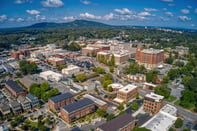Published on
The Reinvention of Higher Ed: Rethinking Program Offerings

Regional public institutions and under-resourced private colleges and universities with limited endowments face the greatest pressures for sustainability within the higher education community, and changes in demographics and marketplace demands had administrators thinking of how to better tailor programs and operations long before COVID struck. On nearly every campus, this has moved into high gear, and the importance of redesigning infrastructure to help staff efficiency cannot be overstated. Trying to do more with less is not going to be a winning proposition if fewer people are tasked with maintaining a system that itself has not been reinvented.
Staff and infrastructure strategies must support the overarching academic model, which may itself be the wellspring of inefficiency when financial resource limitations are compounded by declining enrollments, decreasing funding or limitations that limit new revenue possibilities, and families that are reeling from economic disruption, excessive income disparity and a pandemic.
To survive, we need to think in a new way and ask whether current configurations are built around a proliferation of siloed majors and the associated resources they require? Are they largely dedicated to imparting specialized knowledge rather than focusing on problem-solving across disciplines? Does the current model really provide the best, most affordable and sustainable education? Does it meet the funding and financial realities of most students and of the workforce of tomorrow?
Many institutions are scrambling to address these questions, with some in various stages of panic, denial or both. Yet difficult though it may be, reinvention cannot be considered unusual in the life of an institution.
Plymouth State University is currently marking its 150th anniversary year and has by necessity needed to reinvent many times as it grew from a normal school to a teachers’ college and ultimately into a comprehensive regional university. Our growth in previous decades paralleled a rise in college admissions nationwide and provided a mix of programs that appropriately suited earlier eras.
The process by which reinventions take place has to be of paramount concern. Removing as many obstacles as possible to combining human, financial and other resources will help spur programmatic innovation, as will strong encouragement from administrative leaders. Faculty and staff will naturally want to preserve aspects of programs that may be the product of decades’ worth of refinements, but to avoid paralysis, clear alternative pathways and options beyond the status quo must be provided.
Plymouth State is a regional public institution that believes strongly in academic excellence and student support, in a state and region with limited higher education funding, declining demographics and family economic challenges exacerbated by the pandemic. Our strategy was to develop seven cross-cutting areas of excellence and preparation that matched our strengths and the needs of the 21st century. Beginning in 2016, we folded our majors into these clusters and have begun to form cluster majors with disciplinary tracks. We decided we couldn’t do everything well with the resources available and recently eliminated some individual majors. These have been hard issues to face.
Deciding on whether to curtail or eliminate programs can be a challenging and emotional process. It’s crucial to conduct market analysis and financial modeling, so all parties can review a common set of facts when making decisions. This data is also critical in illuminating the way forward, as institutions must sharpen the uniqueness of their missions by not only reducing programs but also envisioning new ones built on existing strengths.
Concomitant with our ongoing redesign of higher education has been a system-wide push to centralize back-office functions (with distributed execution) to improve efficiencies. Breaking down barriers that previously unnaturally separated academic fields and administrative functions has produced crucial financial efficiencies, and the net change to date in terms of personnel has been a reduction on our campus of 20–25% of our staff and a more recent reduction in tenured faculty.
The cluster concept has made faculty and administrators more inclined to consider interdisciplinary partnerships. One example involves business and music, which at other times might have been far apart in their learning outcomes and anticipated career paths, yet the business side of music is a highly attractive, well established and potentially quite lucrative line of work, with impresarios, promoters and other professionals standing astride both fields. Faculty from both disciplines are currently rethinking pedagogy and new courses may be offered to help bridge the gap through a proposed new program in music production and entrepreneurship.
Reinvention requires the input of many perspectives, so the Campus Transition Leadership Team was created to partner, coordinate, recommend and communicate across the university. The team provides important on-the-ground reporting on how changes are being implemented, what sticking points need attention and what synergies are being achieved. In light of the pandemic, the group is identifying actionable steps, with priorities including equipping our students for the 21st century global economy, recruitment and enrollment, retention and persistence, and sustainability and thriving.
A healthy dose of honesty is also required. We are still in the midst of transition, both administratively and academically, and it is hard at times to see the promise. Our new structures can pose challenges, workloads have increased, and morale can be up and down. Birthing new ideas never comes easily.
However, there really is no choice if you truly want to create a better education that is also affordable in this environment. The silver lining of having embarked on comprehensive reinvention means that our efforts to increase efficiency can be more closely aligned with our mission of service to our state and region.
Disclaimer: Embedded links in articles don’t represent author endorsement, but aim to provide readers with additional context and service.
Author Perspective: Administrator



